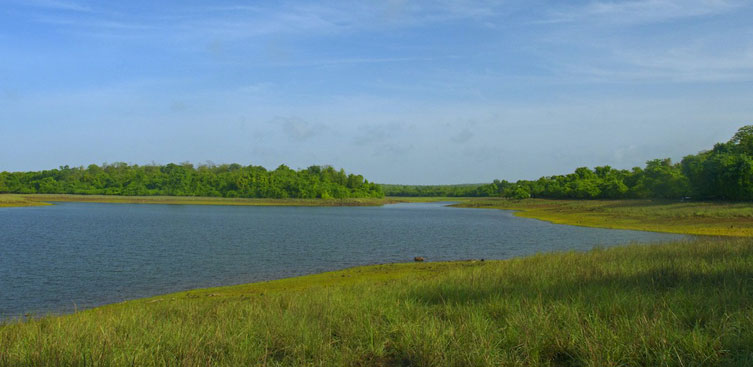Here is a list of top 5 things to do in Tadoba National Park

Tadoba National Park nestled in the Chandrapur district of Maharashtra, India boasts a captivating landscape that enthrals both nature enthusiasts and wildlife photographers alike.Tadoba is renowned for its rich flora diversity characterized by dense teak forests, interspersed with bamboo thickets, mahua, jamun, and other tropical deciduous trees. The landscape is a harmonious blend of greenery providing a picturesque backdrop for wildlife sightings.
The park is adorned with several perennial and seasonal water bodies, including Tadoba Lake, Kolsa Lake, and Andhari River, which serve as crucial watering holes for the wildlife during the scorching summers. These serene lakes and meandering rivers enhance the park's scenic charm and offer excellent opportunities for birdwatching.The park is dotted with natural caves and ravines, formed by centuries of geological processes. These geological formations not only add an element of intrigue to the landscape but also serve as shelter for various species of wildlife, including sloth bears and leopards. Let’s read on the list:
1. Jeep Safari for Big Cat and Wildlife Sightings in Tadoba: plunge into a jeep safari in Tadoba National Park offers an exhilarating opportunity to encounter its diverse wildlife including the majestic big cats like tigers and leopards along with a myriad of other fascinating creatures.Tadoba is renowned for its healthy tiger population making it one of the best places in India to spot these magnificent creatures in their natural habitat. During the safari, experienced guides and naturalists employ their knowledge of tiger behavior and tracking skills to maximize your chances of sighting these elusive big cats.While big cats steal much of the limelight; Tadoba is teeming with a diverse array of wildlife waiting to be discovered.
2. Boat ride in Irai lake: Exploring Irai Lake on a boat ride offers a serene and captivating experience amidst the natural beauty of Tadoba's surroundings. As you glide across the tranquil waters of Irai Lake, you will be surrounded by pristine natural scenery. The lake is nestled amidst lush greenery, with dense forests and rolling hills providing a picturesque backdrop for your journey.Irai Lake is a haven for birdwatchers, boasting a rich diversity of avian species. Keep your binoculars handy to spot colorful kingfishers, majestic eagles, graceful herons, and a variety of waterfowl as they flit among the trees or soar overhead.
3. Bird Around the Lakes of Tadoba: The lakes in and around Tadoba National Park attract a diverse range of bird species, offering birdwatching enthusiasts ample opportunities to observe and admire avian biodiversity.Lakes such as Tadoba Lake, Kolsa Lake, and Irai Lake attract various waterfowl species, including ducks, geese and waders. Look out for Indian spot-billed ducks, lesser whistling ducks, cotton pygmy geese, and common coots paddling in the shallows or gliding gracefully across the water's surface.
4. Butterfly Garden: Butterfly gardens typically feature a variety of native flowering plants that attract butterflies with their nectar. These plants may include milkweed, butterfly bush, lantana, verbena and marigolds among others. In the vicinity of Tadoba, efforts to cultivate such gardens could focus on native plant species that naturally occur in the region and provide food and habitat for butterflies.In addition to nectar plants, butterfly gardens often include host plants where butterflies lay their eggs. Different butterfly species have specific host plant requirements for their larvae to feed on. By incorporating host plants like milkweed for monarch butterflies or citrus plants for swallowtails, the garden can support the complete life cycle of butterflies.
5. Visit Sevagram, Gandhiji’s Ashram: Visiting Sevagram, Mahatma Gandhi's ashram offers a profound opportunity to delve into the life and teachings of one of the world's most influential figures in the realm of peace and nonviolence. Located near the city of Wardha in Maharashtra, India, Sevagram served as Gandhi's residence and headquarters for much of his later life. Sevagram holds immense historical significance as the ashram where Mahatma Gandhi lived and worked during India's struggle for independence from British rule. Gandhi moved to Sevagram in 1936.